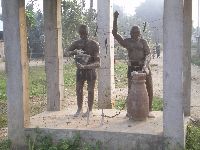 The route out of Lokossa is fairly flat and largely more of the same -- a nice
bicycle ride through green woodlands and farmlands. The landscape continued to be lush with the occasional
village set back in the trees. A morning fog kept it cool but also
didn't foster a lot of easy photo opportunities. One subject that did
catch my eye was a sculpture, but the lighting was difficult.
The route out of Lokossa is fairly flat and largely more of the same -- a nice
bicycle ride through green woodlands and farmlands. The landscape continued to be lush with the occasional
village set back in the trees. A morning fog kept it cool but also
didn't foster a lot of easy photo opportunities. One subject that did
catch my eye was a sculpture, but the lighting was difficult.
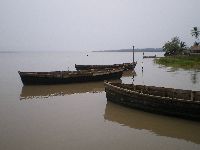 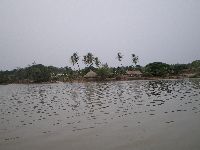 The obvious route to Oudiah is to take the highway to Como and turn left
onto an even busier highway.
Looking for something different we abandoned the highway and headed for the
lakeside village of Bopa on the northwest side of Lake Aheme. The map
didn't have a lot of detail for this area but suggested that there might be some kind of track that
paralleled the highway down the west side of the lake.
The obvious route to Oudiah is to take the highway to Como and turn left
onto an even busier highway.
Looking for something different we abandoned the highway and headed for the
lakeside village of Bopa on the northwest side of Lake Aheme. The map
didn't have a lot of detail for this area but suggested that there might be some kind of track that
paralleled the highway down the west side of the lake.
 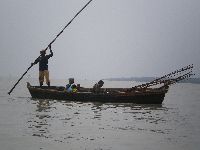 In
Bopa we discovered that negotiating for a boat across the lake would
not be too arduous and the maps suggested there would be some kind of road
out from
the east side of the lake. So we abandoned the In
Bopa we discovered that negotiating for a boat across the lake would
not be too arduous and the maps suggested there would be some kind of road
out from
the east side of the lake. So we abandoned the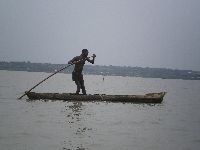 asphalt highway for the "Lake Aheme Marine Highway". Don't be deceived, there
is nothing rushed about the marine highway. No motor boats were seen
or heard. In fact, the lake must be very
shallow and the poling that propels the boat is anything but hasty. It took
about an hour to cross the lake -- a distance of two to three kilometers.
asphalt highway for the "Lake Aheme Marine Highway". Don't be deceived, there
is nothing rushed about the marine highway. No motor boats were seen
or heard. In fact, the lake must be very
shallow and the poling that propels the boat is anything but hasty. It took
about an hour to cross the lake -- a distance of two to three kilometers.
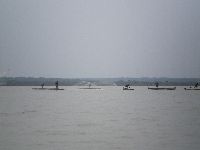  Even
so there was a curious amount of boat congestion on the lake. It turns out
that this was cooperative fishing enterprise with casting nets. The fishermen
would form an open circle and then all cast their nets into the center at
the same time. Even
so there was a curious amount of boat congestion on the lake. It turns out
that this was cooperative fishing enterprise with casting nets. The fishermen
would form an open circle and then all cast their nets into the center at
the same time.
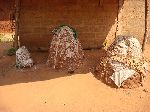 As
we had hoped, there were roads on the east side of the lake, but the roads had
no directional signs. As might be
expected from an area with very few traffic generators, there was also almost no
traffic. As
we had hoped, there were roads on the east side of the lake, but the roads had
no directional signs. As might be
expected from an area with very few traffic generators, there was also almost no
traffic. 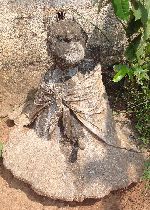 The real interesting aspect of this new area was the marks of
Voodoo culture / religion. (This is not the voodoo of television cartoons,
but it is the origins of the many of the African elements of religions in
Brazil, Haiti and Cuba.) The coastal area of Benin and Togo is
considered the home and heart of the Voodoo culture. The roadside evidence The real interesting aspect of this new area was the marks of
Voodoo culture / religion. (This is not the voodoo of television cartoons,
but it is the origins of the many of the African elements of religions in
Brazil, Haiti and Cuba.) The coastal area of Benin and Togo is
considered the home and heart of the Voodoo culture. The roadside evidence
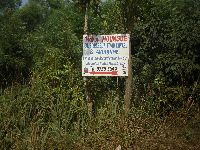 came in the form of household shrines and altars. While they generally
take the same form there seems to be no effort to make them identical so they
are very individualistic and interesting. Another indicia of a change of
culture was the prevalence of roadside signs advertising the location and
services of traditional healers. came in the form of household shrines and altars. While they generally
take the same form there seems to be no effort to make them identical so they
are very individualistic and interesting. Another indicia of a change of
culture was the prevalence of roadside signs advertising the location and
services of traditional healers.
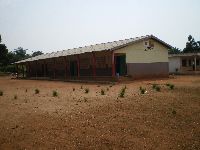 With the long-established life practices there is also validation of how dynamic Benin is:
Along the road there were multiple modern development projects such as schools
(the school shown here is a Japan-Benin cooperative project), clinics, improved
water supplies, some rural electrification and occasional signs of the infancy
of agro-industry.
With the long-established life practices there is also validation of how dynamic Benin is:
Along the road there were multiple modern development projects such as schools
(the school shown here is a Japan-Benin cooperative project), clinics, improved
water supplies, some rural electrification and occasional signs of the infancy
of agro-industry.
Eventually our bucolic route arrived at the highway, we crossed it and found
that we had arrived in the center of Ouidah without having used the asphalt highway for
the last half the day.
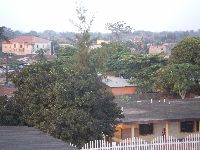 Mostly
Ouidah is a low-rise town with an admirable amount of tree cover. From the vantage
point of the hotel roof one can see that most of the roofs are metal or tiles,
though some of the metal roofs are heavily rusted. Predominantly the
buildings in the city center are constructed with cement blocks that are study
and have a long lifespan. The preferential colors for buildings are pink,
mustard yellow and white -- merging into a single color from the reddish tinge from a coating of dust. Mostly
Ouidah is a low-rise town with an admirable amount of tree cover. From the vantage
point of the hotel roof one can see that most of the roofs are metal or tiles,
though some of the metal roofs are heavily rusted. Predominantly the
buildings in the city center are constructed with cement blocks that are study
and have a long lifespan. The preferential colors for buildings are pink,
mustard yellow and white -- merging into a single color from the reddish tinge from a coating of dust.
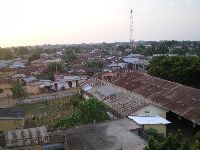
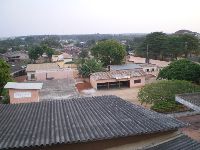
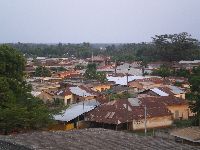
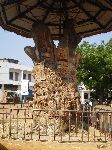 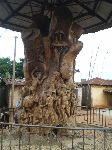 In
the center of Ouidah are the remains of what must have been a grand old
cottonwood tree. The old tree trunk has been given an extended life as a
elaborately carved record of the history that past by it. The relief
reflects slavery, war, colonialism, royalty, religion and culture. In
the center of Ouidah are the remains of what must have been a grand old
cottonwood tree. The old tree trunk has been given an extended life as a
elaborately carved record of the history that past by it. The relief
reflects slavery, war, colonialism, royalty, religion and culture.
 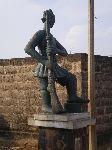 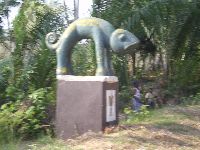 Ouidah
most rapid development came from slaving enterprises in the 18th century.
This is now memorialized with the "Route of the Slaves" and a monument to
those affected. The Route of the Slaves, which runs for a several
kilometers between the town and the coast, is lined by sculpture that
reflect history, culture and proverbs. On the right above are a chameleon
and a female warrior. Ouidah
most rapid development came from slaving enterprises in the 18th century.
This is now memorialized with the "Route of the Slaves" and a monument to
those affected. The Route of the Slaves, which runs for a several
kilometers between the town and the coast, is lined by sculpture that
reflect history, culture and proverbs. On the right above are a chameleon
and a female warrior.
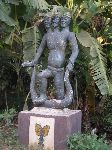
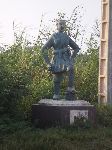

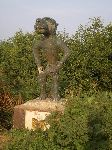
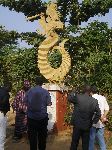

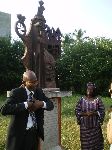
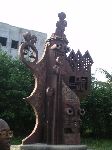
Aidohwedo is the rainbow god and also the god of
continuity and wealth.
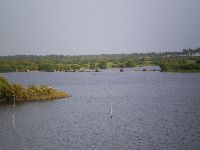 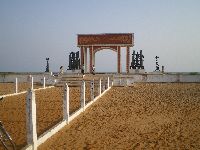 Past
the coastal estuary and lagoon, where the Route of the Slaves reaches the
ocean the is an impressive memorial to the victims of the Atlantic slave
trade. This would have been the door of no return, where captives would have
been loaded on to ships for the middle passage to the Americas. Past
the coastal estuary and lagoon, where the Route of the Slaves reaches the
ocean the is an impressive memorial to the victims of the Atlantic slave
trade. This would have been the door of no return, where captives would have
been loaded on to ships for the middle passage to the Americas.
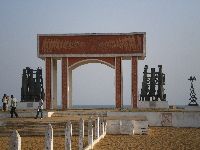
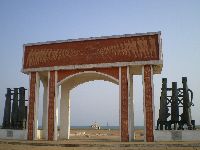

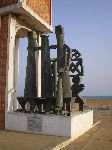
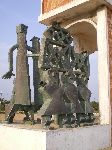
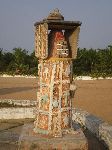

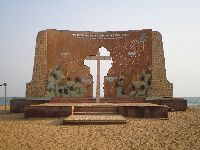 Near
by is a monument to the millennium and Christianity. Near
by is a monument to the millennium and Christianity.
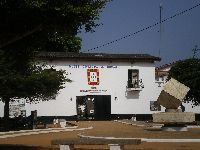  Back
in town, the Portuguese fort, Fortaleza Sao Joao Batista, built in 1721 to facilitate the slave
trade, has been restored to serve as a museum. Most of the exhibits are
reproductions of materials on slavery. Photography of the interior is
now
prohibited, but here is a photograph of the front gate and exhibit material
from a different source. Back
in town, the Portuguese fort, Fortaleza Sao Joao Batista, built in 1721 to facilitate the slave
trade, has been restored to serve as a museum. Most of the exhibits are
reproductions of materials on slavery. Photography of the interior is
now
prohibited, but here is a photograph of the front gate and exhibit material
from a different source.
The central market is shaded by the canopies of large trees. In the
middle of the day it offered some relief to the heat and humidity of the
unprotected streets.
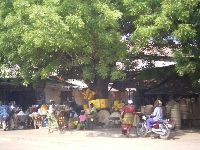
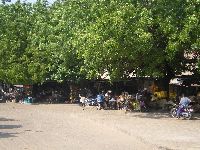
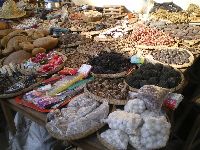
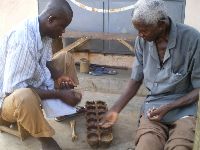 Perhaps it was the afternoon heat which prompted these gentlemen to take a
break from whatever they were doing to compete at the seed game. The
game, with slight variations, is played across sub-Saharan Africa.
The main difference from place to place is the name. In the KoGbe speaking
part of Benin the game is called ajato. Some of the other names is
West Africa are: wori (Malinke, Mali),
gbo walo (Bassa, Liberia), ma kpo (Mano, Liberia), tay gbo knongi (Gbandi,
Liberia), mana (Kpelle, Liberia),
wrah (Kru, Liberia), wosley (Ivory Coast), owari (Twi, Ghana), aju (Ewe,
Togo), ayo (Yoruba, Nigeria), bmang (Grassfields, Cameroon), and, mankala
(Disney).
Perhaps it was the afternoon heat which prompted these gentlemen to take a
break from whatever they were doing to compete at the seed game. The
game, with slight variations, is played across sub-Saharan Africa.
The main difference from place to place is the name. In the KoGbe speaking
part of Benin the game is called ajato. Some of the other names is
West Africa are: wori (Malinke, Mali),
gbo walo (Bassa, Liberia), ma kpo (Mano, Liberia), tay gbo knongi (Gbandi,
Liberia), mana (Kpelle, Liberia),
wrah (Kru, Liberia), wosley (Ivory Coast), owari (Twi, Ghana), aju (Ewe,
Togo), ayo (Yoruba, Nigeria), bmang (Grassfields, Cameroon), and, mankala
(Disney).
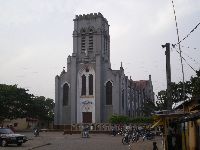  The
Western religion vying with Voodoo for dominance in this section of Benin is
Catholicism. The large neo-gothic cathedral in the center of Ouidah is
one of the tallest buildings in town. The
Western religion vying with Voodoo for dominance in this section of Benin is
Catholicism. The large neo-gothic cathedral in the center of Ouidah is
one of the tallest buildings in town.
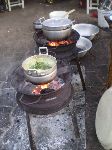 To finish the day,
we dined al fresco again. The cook offered an "a la pot" choice of rice,
beans, fish and an assortment of sauces. To finish the day,
we dined al fresco again. The cook offered an "a la pot" choice of rice,
beans, fish and an assortment of sauces.
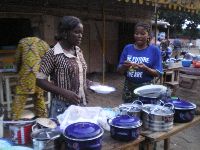

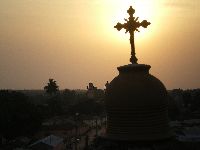 Sunset
in Ouidah. Sunset
in Ouidah.
|
 The route out of Lokossa is fairly flat and largely more of the same -- a nice
bicycle ride through green woodlands and farmlands. The landscape continued to be lush with the occasional
village set back in the trees. A morning fog kept it cool but also
didn't foster a lot of easy photo opportunities. One subject that did
catch my eye was a sculpture, but the lighting was difficult.
The route out of Lokossa is fairly flat and largely more of the same -- a nice
bicycle ride through green woodlands and farmlands. The landscape continued to be lush with the occasional
village set back in the trees. A morning fog kept it cool but also
didn't foster a lot of easy photo opportunities. One subject that did
catch my eye was a sculpture, but the lighting was difficult.
















































